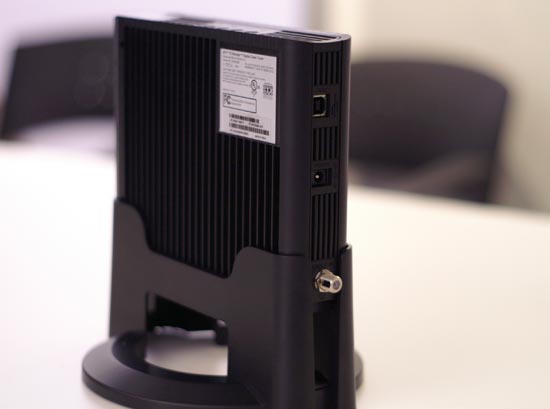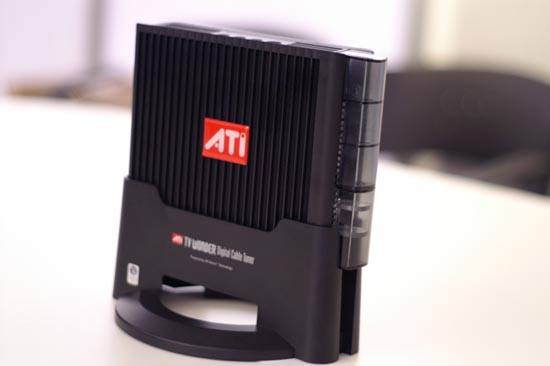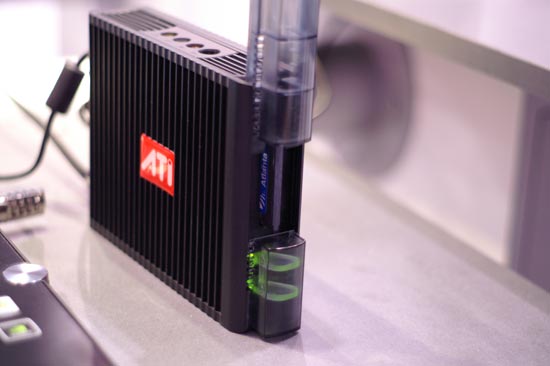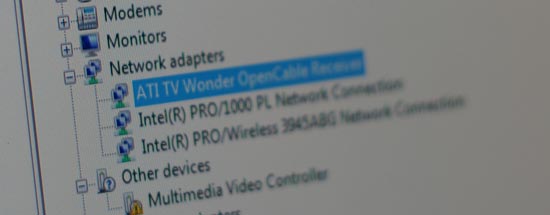CES 2007 Part I: Convergence Happened and the Most Impressive Demo of CES
by Anand Lal Shimpi on January 11, 2007 6:53 PM EST- Posted in
- Displays
ATI’s OCUR is Introduced
The most exciting story of last year’s CES was ATI’s OCUR (Open Cable Unidirectional Receiver) device; although at the time all we knew that it would officially launch when Vista was released due to its dependency on a protected path through the PC. With Vista’s retail release less than a month away, it’s no surprise that AMD (formerly ATI) had a final production version of its OCUR device on display and working at CES.

The official product name of OCUR is the ATI TV Wonder Digital Cable Tuner by AMD, and as expected it will be available in two versions: internal and external. The TV Wonder DCT is currently an OEM-only product and it will remain so until there’s enough trust built between the cable industry and the PC users in order to start making it more accessible.


The TV Wonder has a set of AV inputs for external devices

For those that don’t remember, the point of the TV Wonder DCT is to bring CableCard support to Windows Vista Media Center. Currently, you can’t use Media Center Edition to record digital cable or non-OTA HD content. AMD’s product is the only way of getting CableCard support on your PC, and implementation is fairly simple. You plug your cable into a coax port on the back of the unit and then plug the unit in to your computer via USB 2.0. The internal version also operates over USB, despite being a standard PCI card.
Your CableCard goes in a slot on the front of the TV Wonder; a cover slides open to reveal the CableCard slot:

To enable support for the TV Wonder the motherboard must include a flag in the BIOS to tell Vista that it supports the tuner. There’s also a product ID that needs to be entered in Vista, but most OEMs will probably be entering this on their own so that it is completely transparent from the end user. It’s sounding like it won’t be too easy/feasible to simply take the unit and install it on a different computer from the one it originally came on.

Using the TV Wonder in Vista works just like any other tuner in Media Center, just change channels and record shows like you normally would, the only difference is that you now have access to premium and non-OTA HD content. Availability will be in OEM systems on January 30th with Vista’s launch.











18 Comments
View All Comments
Johnmcl7 - Friday, January 12, 2007 - link
Can't say I agree with that, while LCDs are thin and light their image quality leaves a lot to be desired especially given the superior image quality of the CRTs they've effectively replaced.John
PrinceGaz - Sunday, January 14, 2007 - link
That very much depends on the type of LCD panel used. Maybe it's because my Mitsubishi 2070SB CRT display is about four years old and isn't as good as it used to be, but the overall image quality (including colour reproduction) of my new HP LP2065 which uses an S-IPS LCD panel is just as good as it. The response-time is also sufficiently fast that their is no visible blurring of fast moving images. And the 2070SB wasn't some cheapo CRT either, it was one of the best 20" visible CRT monitors you could get.The fact that the LP2065 was just a little over half the price of the old 2070SB actually makes modern LCD displays seem superior to CRTs, especially when the lower power consumption is factored in. It is also slightly (ahem!) less bulky and heavy than the old CRT monitor. It makes me wish I'd switched to an LCD sooner except of course that even a year or two ago, the picture quality of the best LCD panels wasn't anywhere near what it is today.
Give a *good* (in other words one that does not use a TN panel) LCD display a chance and you'll probably be surprised.
msva124 - Monday, January 15, 2007 - link
Does it scale well to different resolutions? I.E. for gaming.tumbleweed - Thursday, January 11, 2007 - link
"the display is superb, making it very similar to reading pages in a regular book"Hardly. It's dark grey on light grey, thus having less than stellar contrast. No, this really isn't similar to reading a regular book; it's similar to reading an ATM receipt. Once they get it to the point of true blank on something resembling white, then we can talk. Other than that, I'll admit it's nifty, but the display quality ain't there yet.
msva124 - Thursday, January 11, 2007 - link
OMG! It's almost as good as one as those CRT things that Nostradamus said would be here in the year 3000!GhandiInstinct - Thursday, January 11, 2007 - link
I AM SOLD ON OLED!!!!! Come get me!BladeVenom - Friday, January 12, 2007 - link
Last time I checked, OLED displays had a very short lifespan. That may be OK if you don't use it much, or like replacing your monitor every year, but I think many will have a problem with that.psychobriggsy - Friday, January 12, 2007 - link
They've even got blues up to >30k hours now. That's a lot of TV watching, although some people sure do like to watch TV all day.Anyway, I'm sure I read that these Sony displays used a single colour OLED throughout, with colour filters on top. White OLEDs can have very long lives. If they're using 100k hour OLEDs, and you have the TV on for 10 hours a day because you cannot bear the idea of not having it on, then that is 30 years before the display is ~half as bright as originally. I think that predicting television display technology in 2037 will be quite difficult.
I'm just hoping that one day OLEDs will actually really be available in large displays! Can't wait yet another 5 years...